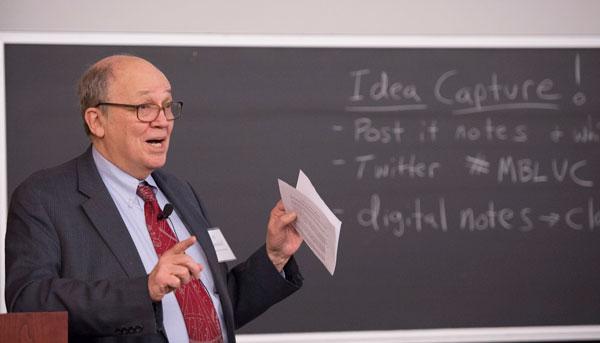
Credit: University of Chicago News Office
WOODS HOLE, Mass. — William S. Reznikoff, senior research scholar at the Marine Biological Laboratory (MBL) and professor emeritus at University of Wisconsin-Madison, has been elected a Fellow of the American Association for the Advancement of Science (AAAS).
AAAS members bestow the honor of Fellow upon their peers in recognition of “scientifically or socially distinguished efforts to advance science or its applications.”
Reznikoff was cited for “deciphering the molecular details of transposition by studying a model bacterial transposon.” His election is within the association’s Division of Biological Sciences.
Reznikoff has held a research position at the MBL since 2004 and was formerly MBL Director of Education (2010-2015). He is a member of the MBL Society and served on the Microbial Ecology course faculty in 1981 and 1982.
An important agent of genome evolution, transposition in is the movement of a defined DNA segment (a transposon) from one site in the genome to another. Transposons and other mobile DNA elements can generate spontaneous mutations, regulate gene expression, and move genes from one microbial species to another. Besides their significance to basic science, foundational studies of transposition in bacteria by Reznikoff and others have had important applications, including the development of drugs to block infection by HIV-1 (the virus that causes AIDS). Reznikoff also collaborated with Hilary Morrison, senior scientist in the MBL’s Josephine Bay Paul Center, to develop an efficient method for preparing DNA for sequencing that drew upon his biochemical studies of transposition. This invention was licensed by the Wisconsin Alumni Research Foundation, in collaboration with Reznikoff’s lab, to a Wisconsin biotechnology company that was later acquired by Illumina. It is still used to prepare DNA for next-generation sequencing.
This year’s AAAS Fellows will be formally announced in the journal Science on Nov. 27, 2020. A virtual induction ceremony will be held in February 2021.
More Background on Reznikoff’s Citation
DNA transposons were first described in the 1940s by Barbara McClintock, who received a Nobel Prize for her discovery in 1983.
Reznikoff accidentally began working on transposition in the late 1960s, while a postdoctoral fellow with Jonathan Beckwith at Harvard Medical School. “We were using a lot of bacterial genetics techniques that we didn’t know at the time were based on insertion sequences (also called transposons),” Reznikoff says. He joined the faculty at the University of Wisconsin-Madison in 1970, where he and collaborators began studying the structure of bacterial genes that carry antibiotic resistance; these genes were carried on transposons. In 1980 Reznikoff’s laboratory finally began focusing on the mechanism of transposition per se, and in so doing they developed an influential model system for transposition research (the Tn5 transposon in the bacterium E. coli).
“We were lucky in that were we able to study transposition not only in a living bacterium, but we also developed a simple in vitro system for studying how the DNA transposon is moved from one site to another,” he says. This purified system allowed them to describe the biochemical reaction that catalyzes the movement of the DNA to its new place in the genome. His lab then successfully determined the three-dimensional structure of the complex formed by the transposon (the DNA) and the transposase (the protein that catalyzes its movement), which had never been done before. A summary of this important work appeared in Science in 2000.
Other MBL affiliates named AAAS Fellows this year include:
Section on Biological Sciences:
Leah E. Cowen (faculty, Molecular Mycology 2006; alumna, Molecular Mycology 1999)
Dana Crawford (alumna, Invertebrate Zoology 1975)
Jonathan A. Eisen (faculty, Molecular Evolution 2000-2004; alumnus, Molecular Evolution 1994)
Andrea L. Graham (alumna, Biology of Parasitism 1996; alumna, Analytical and Quantitative Light Microscopy 1996)
Michael William Gray (faculty, Molecular Evolution 1997)
Paul E. Hardin (alumnus, Embryology 1986)
Nancy Hollingsworth (alumna, Physiology1981)
Eaton E. Lattmann (alumnus, Physiology1964)
Hiten Madhani (faculty, Molecular Evolution 2017)
Jennifer B.H. Martiny (faculty, STAMPS 2013)
Antonis Rokas (faculty, Molecular Evolution 2010-2015, STAMPS 2011; alumnus, Molecular Evolution 2000)
Jason Stajich (faculty, Molecular Mycology 2012)
Rick L. Tarleton (faculty, Biology of Parasitism 2001-2004)
Fitnat Yildiz (alumnus, Microbiology 1988)
Section on Education:
John K. Haynes (alumnus, Physiology 1976, Embryology 1966)
David J. Marcey (alumnus, Biomedical Informatics 1996, 1997, Optical Microscopy 1997, Neurobiology 1978)
Section on History and Philosophy of Science:
Rachel Ankeny – History of Biology Seminar participant
Section on Medical Sciences:
Yasmine Belkaid (faculty, Biology of Parasitism 2008-2011)
Bruce T. Liang (alumnus, Physiology 1987)
Section on Neuroscience:
Gabriel Corfas (faculty, Neurobiology 1997, 1998; alumnus, Neural Systems & Behavior 1987)
Steve Goldstein (faculty, Neurobiology 1992)
Stephen G. Lisberger (faculty, Neural Systems & Behavior 1991)
Section on Pharmaceutical Sciences:
Patricia C. Babbitt (alumna, Biomedical Informatics 1999)
Section on Psychology:
Elaine M. Hull (alumna, Rapid Electrochemistry 2000)
Section on Societal Impacts of Science and Engineering:
Oladele A. Ogunseitan (Whitman Scientist 1999, 2000)
###
Media Contact
Diana Kenney
[email protected]
Original Source
https:/




